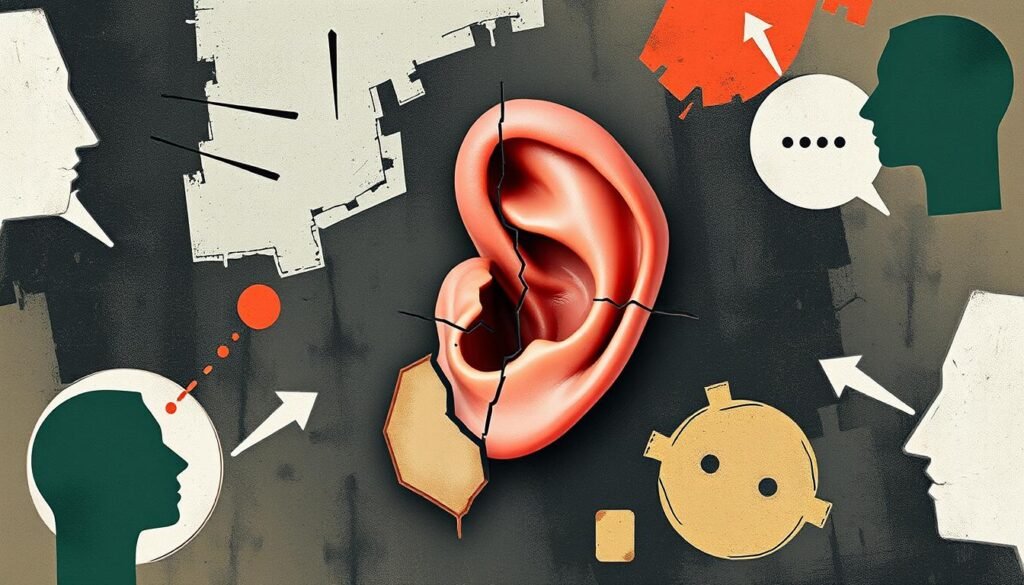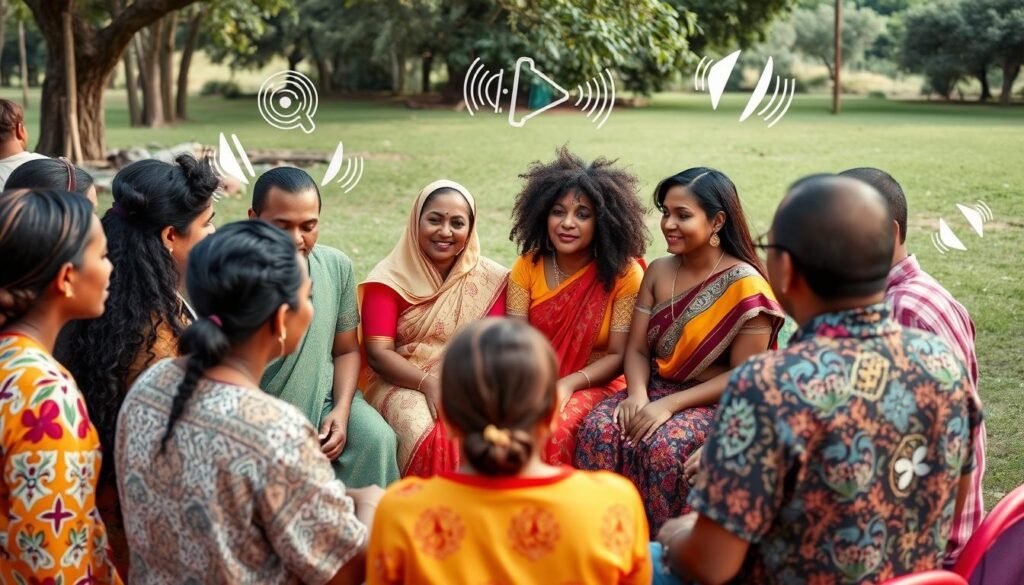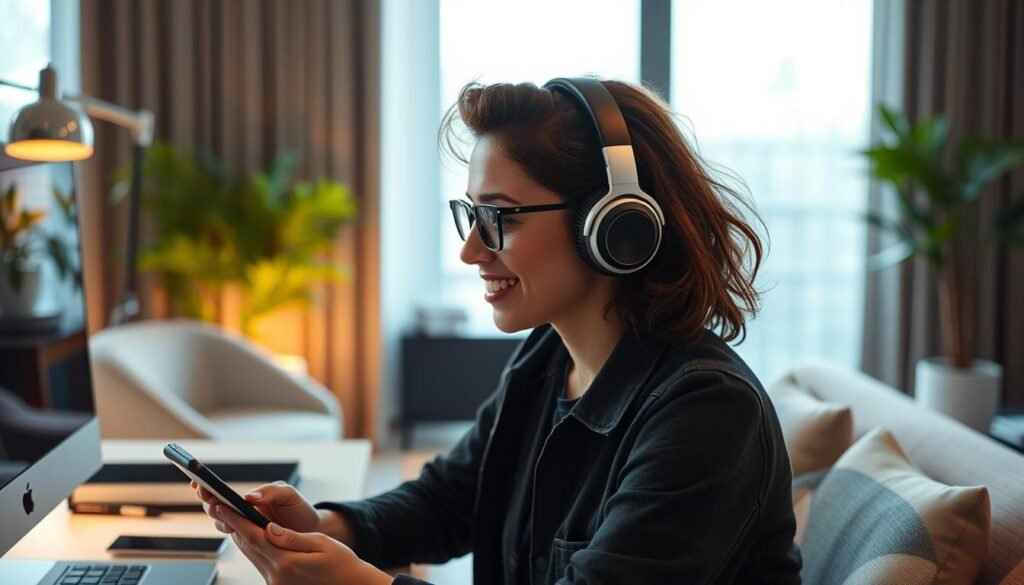Did you know that we only remember about 25% of what we hear after two months? This fact shows how vital active listening is in our daily talks1. As someone who studies communication, I’ve seen how good listening can change how we connect with others. It makes a big difference in both our personal and work lives.
Listening actively means more than just hearing words. It’s about really getting what the speaker is saying, understanding it, and responding well. This skill is key for good communication. It can also make our relationships and careers better. In fact, the need for skills like active listening is expected to jump by over 20% in many jobs by 20301.
In healthcare, active listening is crucial for success and fewer mistakes. It’s not just about what we say; how we act and touch also matters. This way of listening helps build trust, solve problems, and make a better work place.
In work settings, active listening is key for teamwork and leadership. It helps us solve problems by finding the real issues and new solutions. It’s also important in job interviews, helping us understand questions and answer better2. By getting better at listening, we can make deeper connections, learn more, and do well in our jobs and personal lives.
Key Takeaways
- Active listening greatly improves how well we remember information
- The need for active listening skills is rising in many fields
- Body language and touch are key in active listening
- Good listening helps solve problems and fix conflicts
- Working on our listening skills can help our careers
- It’s vital for a positive work atmosphere
- We can always get better at listening by learning more
Understanding Active Listening
Active listening is more than just hearing words. It’s about paying full attention, understanding feelings, and building connections. Let’s dive into what it is, why it matters, and its benefits.
Definition and importance
Active listening means fully engaging with someone, both in words and body language. It’s about getting the message and the feelings behind it. This skill is key for good communication in both personal and work life3.
By not judging and being patient, we can really get what the speaker is saying3.
Benefits in personal and professional settings
Active listening has a big impact. It builds trust and can make emotional connections stronger3. At work, it can lead to big improvements. Managers who listen well see a 30% jump in employee happiness. They also see better teamwork and productivity, up to 25%4.
Even sales can get an 8% boost with good listening skills4.
Difference between hearing and listening
Hearing is just passive, but listening is active. Listening uses all our senses to get what’s being said. It’s about reflecting back and asking for more clarity3.
This shows we care and understand. Julian Treasure talks about a four-step process called RASA (Receive, Appreciate, Summarize, Ask) to improve listening5.
| Aspect | Hearing | Active Listening |
|---|---|---|
| Engagement | Passive | Active |
| Focus | Sound reception | Understanding and empathy |
| Response | None or minimal | Thoughtful and engaged |
| Outcome | Basic comprehension | Deeper understanding and connection |
Improving our listening skills helps us connect better with others3. It’s not just good, it’s essential for building strong relationships in all areas of life.
The Psychology Behind Active Listening
Active listening is a powerful tool rooted in empathetic understanding. It’s more than just hearing words. It involves understanding both what is said and what is not said. This way, we can really get what another person is thinking without judging them.
Studies show that when we listen carefully, we grow emotionally. We become more open and less defensive. We also start to listen better to our own thoughts and feelings6.

The psychology of active listening is about creating a space of equality and warmth. This space helps us communicate better and build strong relationships. Interestingly, active listening can change our attitudes more than any other activity6.
A study with 18 participants looked at how active listening affects us. They found that when we see active listening, our brains respond differently. This shows how important active listening is for our minds7.
Active listening and empathy make relationships better. They help couples, families, and coworkers connect on a deeper level. By listening actively, we tell others, “You’re not alone.” This can heal and strengthen our bonds with others8.
Active Listening Remarkable Techniques
Active listening is a skill that can change how we talk to each other. By learning key techniques, we can better understand and connect with people. Let’s look at three amazing ways to improve our listening skills.
Being Fully Present
First, we need to give our full attention to the person talking. This shows we respect and value their thoughts. It helps us understand better and builds trust, which is key for personal growth and building relationships. Being fully present also makes us more empathetic and better at reading the speaker’s tone and body language9.
Using Nonverbal Cues
Nonverbal cues are crucial in active listening. Keeping eye contact, using open body language, and nodding shows we’re engaged. These signals help the speaker feel heard and share more. In customer service, they can make people happier by showing they’re being listened to10.
Asking Open-Ended Questions
Lastly, asking open-ended questions is a great technique. It invites deeper answers and shows we’re really interested. Thoughtful questions help us understand the speaker better. This is especially useful in solving problems, as it gives us more information and ideas10.
Using these active listening techniques can greatly improve our communication. They make our personal and work interactions better. These methods help create a more positive and productive environment910.
Barriers to Effective Active Listening
Effective communication is key, but many struggle to listen well. People talk at 125 to 175 words per minute. Meanwhile, our brains can process 400 to 800 words per minute1112. This difference often causes us to drift off, making it hard to stay focused.
Distractions are a big problem for active listening. In fact, 70% of people find it hard to ignore their own plans while listening13. About 30% are distracted by sounds around them13. Smartphones, in particular, can quickly pull our attention away during talks12.

Our emotions and preconceptions can also block effective listening. Around 40% of people struggle with strong feelings that make it hard to listen13. About 50% of listeners get sidetracked by criticizing the speaker13.
To beat these hurdles, 85% of people say we should stop and really listen13. Paying attention to body language can greatly help, as 70% agree13. By tackling these issues, we can better our listening skills and have more meaningful talks111312.
Developing an Active Listening Mindset
Having an active listening mindset is key for good communication and building rapport. It requires patience, empathy, and self-awareness. These qualities help us listen deeply and connect with others better.
Cultivating Patience and Empathy
Patience is vital for active listening. It lets speakers share their thoughts fully without being cut off. Research shows we remember only 25% of talks two months later, showing the need for full attention14. Empathy is also crucial, as it lets us see things from others’ viewpoints and feel their emotions. This empathy is the base of strong relationships.
Overcoming Personal Biases
It’s important to recognize and set aside our own biases for effective listening. These biases can distort our view and make it hard to truly hear others. By working to overcome these biases, we open up to new ideas and viewpoints.
Practicing Self-Awareness
Self-awareness is key in managing our emotions during talks. It helps us focus on the speaker, not our own thoughts. Growing self-awareness takes practice and reflection.
| Active Listening Skill | Benefits | Practice Techniques |
|---|---|---|
| Patience | Allows full expression of ideas | Mindful breathing, counting to 10 before responding |
| Empathy | Builds trust and understanding | Perspective-taking exercises, reflective listening |
| Overcoming Biases | Opens mind to new ideas | Consciously challenging assumptions, seeking diverse viewpoints |
| Self-Awareness | Improves focus on speaker | Journaling, meditation, feedback from others |
Improving these skills is more important than ever in today’s work world. The need for social and emotional skills, like active listening, is expected to grow by over 20% by 203014. By focusing on active listening, we can enhance our communication and form deeper connections in both our personal and professional lives.
The Role of Body Language in Active Listening
Body language is key in active listening and better communication. When we listen well, our body signals are very important. A real smile makes us seem more open and trustworthy15.
Leaning forward shows we’re really listening. This action is linked to being positive and talking more15. Open body language, like uncrossed legs, shows we’re ready to listen and chat15.

Mirroring the speaker’s gestures shows we agree or like what they say15. This helps build rapport and shows we’re paying attention. Nodding is also key. Three nods at a time can get people to share more15.
Active listening means fully focusing on the speaker. It leads to better problem-solving and stronger relationships16. Learning these body language tips can greatly improve our communication and business connections1516.
Enhancing Communication Through Paraphrasing
Paraphrasing is a key tool for better communication. It means restating what someone said in our own words. This helps us understand each other better and build stronger connections.
Techniques for Effective Paraphrasing
To get good at paraphrasing, focus on the main points and feelings. This makes the conversation clearer and shows you’re really listening17. Use phrases like “What I’m hearing is…” to show you get it18.
Ask open-ended questions to dive deeper into topics. This makes conversations more meaningful.
Benefits of Reflective Listening
Reflective listening, which includes paraphrasing, is key to good communication. It makes the speaker feel understood, building trust and closeness17. It’s especially useful in work and solving conflicts.
By using reflective listening, we can avoid misunderstandings and calm conflicts. This leads to better and more rewarding relationships1718.
Remember, getting good at paraphrasing and listening takes practice. By doing it often, we can improve our communication and connect better with others.
Active Listening in Conflict Resolution
Active listening is key in solving conflicts. It helps calm tensions and builds understanding between people. Studies show it can make solving conflicts up to 50% better19.
This method means listening without judging, recognizing feelings, and finding the real problems. It’s about understanding, not blaming.

Using active listening, we create a safe place for talking openly. This leads to better solutions that everyone can agree on. Companies that listen well see a 50% jump in employee happiness and a 28% boost in customer satisfaction19.
Active listening helps avoid confusion, clears up issues, and finds common ground. It shows respect and reduces anger and blame, making it easier to find solutions20.
Active listening is the cornerstone of effective communication skills and empathetic understanding in conflict resolution.
To listen actively in conflicts, focus on these skills:
- Being fully present in conversations
- Paying attention to non-verbal cues
- Maintaining good eye contact
- Asking open-ended questions
- Summarizing important points
- Practicing patience20
Companies that listen well have a 25% edge in the market. Training managers in active listening boosts employee engagement by 25% and productivity by 10%19.
Learning active listening can greatly improve our ability to solve conflicts. It enhances our communication and empathy in both personal and work life.
Improving Relationships with Active Listening
Active listening was first mentioned in 1957 by Carl Rogers and Richard Farson. It’s a key way to make relationships better21. This skill helps us connect deeper in both our personal and work lives.
Building Trust and Rapport
Active listening helps build trust and rapport. It makes a safe and supportive place22. By listening without judgment, we let people share openly21.
This shows we truly care, which people find attractive21.
Here are some ways to build rapport:
- Practice empathy to get others’ feelings
- Use open-ended questions to get them to share
- Don’t interrupt to show respect
- Summarize and reflect to show you’re paying attention
Strengthening Personal and Professional Connections
Active listening makes communication better by making sure everyone feels heard22. It builds empathy and compassion, making relationships stronger22. At work, it helps teams work better and clients feel valued.
Using active listening every day can really help us grow emotionally22. By listening mindfully and using body language, we connect better with others22.
“The most basic of all human needs is the need to understand and be understood. The best way to understand people is to listen to them.” – Ralph G. Nichols
Getting better at listening to improve relationships takes practice21. By using these techniques often, we become more empathetic and improve our communication skills everywhere.
Active Listening in Leadership

Leaders who listen well have more engaged teams. They understand their team’s needs and ideas better. Active listening techniques build trust and respect in the workplace.
Research shows that great leaders listen actively. Listening meets our basic needs for feeling important and valued23. However, stress can make us less empathetic23. Emotional intelligence is key for effective listening.
Today’s leaders who listen well will lead tomorrow24. They move from boss to leader by listening more than talking24. This builds trust and teamwork.
“The most basic of all human needs is the need to understand and be understood. The best way to understand people is to listen to them.” – Ralph G. Nichols
Active listening is important outside work too. It strengthens relationships and boosts empathy24. Training in active listening can raise employee satisfaction by 30% and boost teamwork by 25%4.
| Impact of Active Listening | Improvement Percentage |
|---|---|
| Employee Satisfaction | 30% |
| Collaboration and Productivity | 25% |
| Sales Performance | 8% |
To better connect with others, leaders should create time for listening23. By focusing on the speaker, they build trust and relationships23. This improves teamwork and helps solve problems early.
Cultural Considerations in Active Listening
In our diverse world, understanding different cultures is key to good communication. Active listening across cultures means being empathetic and paying attention to body language. For example, “to have an argument” means something different in French than in English25.
Companies that value diversity do well. They keep employees longer, which boosts productivity and profits26. The U.S. Hispanic population has grown a lot, from 12.5% in 1990 to over 16% by 2009. It’s expected to reach 25% by 205027.

- Notice the context, tone, body language, and facial expressions
- Don’t jump to conclusions based on your own culture
- Appreciate the efforts of non-native English speakers
- Learn about different cultures beforehand
Inclusive workplaces make everyone feel comfortable and valued. Companies should focus on being inclusive, diverse, and open. This helps create a united culture26. As the U.S. is set to become a “majority minority” country by 204327, this is more important than ever.
Listening well in diverse settings means reflecting on yourself. The Art of Active Listening helps you understand your biases and improve your communication skills27. By doing this, we can build stronger, more welcoming communities and workplaces.
| Cultural Aspect | Impact on Active Listening | Adaptation Strategy |
|---|---|---|
| Eye Contact | Varies in importance across cultures | Observe and mirror local norms |
| Personal Space | Different comfort levels in proximity | Respect individual boundaries |
| Communication Style | Direct vs. indirect approaches | Adapt to local preferences |
Technology and Active Listening: Challenges and Opportunities
In our digital age, technology changes how we talk and listen. Virtual platforms have changed how we interact, bringing new challenges for listening well. Without face-to-face contact, we miss out on important nonverbal cues.

Yet, technology also brings new chances to improve our listening. Screen sharing lets us use visuals, and recording helps us go back to conversations. This is especially helpful in schools, where teachers are trying to understand students better in the digital world28.
There’s a growing trend of using electronic devices in classrooms. Students like having their phones on vibrate in class, as long as it doesn’t bother others28. This shows we need to adjust our listening skills for the digital age.
“Active listening plays a crucial role in successful open innovation exploration, negotiations, and implementation, in addition to enhancing internal process efficiency and effectiveness.”
But worries about phone addiction and its impact on learning still exist. Research shows students who don’t text do better in quizzes and have better grades28. This highlights the need to balance tech use with listening in learning and work settings.
In business, active listening is key for open innovation and communication29. Companies are investing in workshops to improve communication skills. They focus on better dialogue with outside partners.
| Key Active Listening Skills | Application in Digital Communication |
|---|---|
| Paraphrasing | Summarizing key points in chat or email |
| Asking clarifying questions | Using follow-up messages or comments |
| Demonstrating empathy | Using emojis or empathetic language |
| Avoiding judgment | Practicing open-mindedness in online discussions |
As we move through this tech-driven world, mastering these skills is key. By using technology’s benefits wisely and being aware of its limits, we can improve our communication and listening in both digital and real-life settings.
Measuring the Impact of Active Listening
Measuring the impact of active listening is key to better communication and stronger relationships. By tracking certain signs, we can see how well our listening works and make it better.
Key Performance Indicators
There are important signs to check if active listening is working. These include better team work, fewer fights, and happier customers. Active listening helps teams trust each other more, work together better, and be more creative and productive30.
A study showed hospital managers’ listening skills scored 2.32 out of 3. First-level managers scored the highest at 2.2731. This shows we can measure and compare listening skills across different levels.

Feedback Mechanisms
To see how well active listening works, use different feedback tools. Surveys, peer checks, and self-evaluations give us good feedback. Also, watching how team members open up and counting questions asked shows we’re listening well30.
Active listening also helps us connect better with others and tap into our collective smarts32. We see this in more team input, higher empathy, and smarter decisions30.
By always checking and improving our listening, we build stronger connections and understanding. This ongoing effort is vital for better communication and a positive work place.
Common Misconceptions About Active Listening
Many people think attentive listening is just sitting there quietly. But it’s actually very active. It uses many parts of the brain at once33. It makes talking and solving problems easier.
Some think active listening means you always agree with what’s said. But that’s not right. It’s about really getting what the other person is saying, not just agreeing34. It’s about listening well, asking questions, and giving feedback. This builds trust and makes work better34.
Others think some people are naturally good at listening. While some might be, it’s a skill anyone can learn35. To get better at listening, we need to work on it. We must fight distractions and our own biases. By doing this, we make conversations more meaningful and everyone feels heard35.
FAQ
What is active listening?
Active listening is a skill that means really paying attention to what someone is saying. It’s not just about hearing words. It’s about using all your senses and understanding what’s not said.
Why is active listening important?
It makes communication clearer and builds stronger relationships. It shows respect and helps solve problems. Plus, it’s key in the workplace and can boost your career.
What are the benefits of active listening?
Active listening improves relationships and problem-solving. It boosts productivity and teamwork. It also makes you a better leader and increases empathy.
How does active listening differ from passive hearing?
Active listening is about really focusing and understanding. Passive hearing is just hearing sounds without paying attention. Active listening involves understanding both words and body language.
What are some remarkable techniques for active listening?
Great techniques include being fully present and using positive body language. Ask open-ended questions and paraphrase to show you get it. Reflective listening is also key to understanding emotions.
What are common barriers to effective active listening?
Barriers include distractions and multitasking. Personal biases and focusing on your response can also get in the way. Overcoming these takes effort and practice.
How can body language enhance active listening?
Body language is crucial, making up to 55% of face-to-face communication. Use eye contact, nodding, and facial expressions to show you’re engaged. Mirroring the speaker’s body language helps build rapport.
How can paraphrasing and reflective listening improve communication?
Paraphrasing restates what the speaker said to ensure you understand. Reflective listening, including paraphrasing, shows you’re actively listening. It’s great for professional settings and resolving conflicts.
How can active listening help in conflict resolution?
Active listening is key in resolving conflicts. It helps calm tensions and promotes understanding. By listening without judgment and acknowledging emotions, you create a safe space for dialogue.
